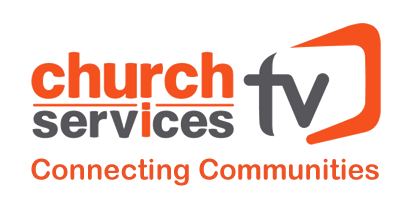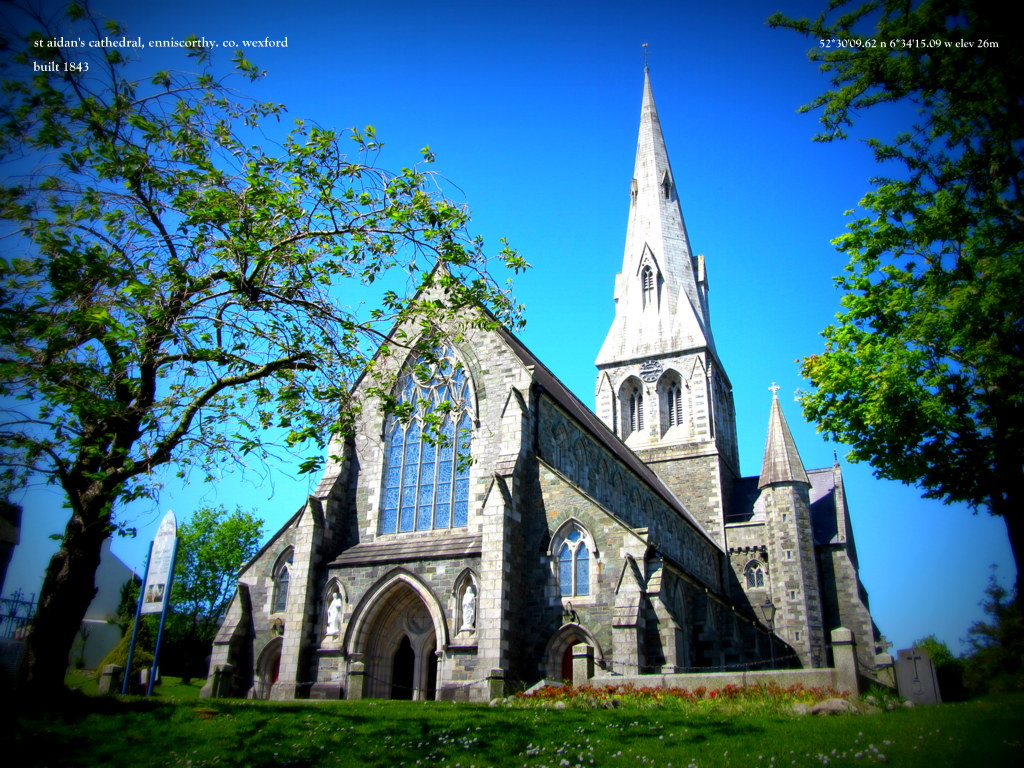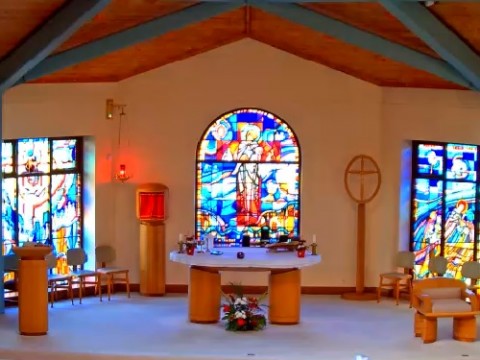Churches of the Day
Pictorial Thought for Today

May 9 - St Pachomius (292-346) founder of communities for monks
Patrick Duffy tells his story.
Impressed by the Kindness of Christians
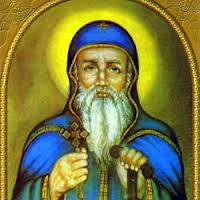
Born in Thebes, Upper Egypt, 292 A.D. Pachomius was conscripted at an early age into the Roman army. Impressed by the kindness of Christians, he became a Christian on his release. Soon he became a disciple of the hermit Palemon, who taught him how to pray and meditate. From him he also learned some of the practical skills of laying stone and bricks.
A Community of Monks
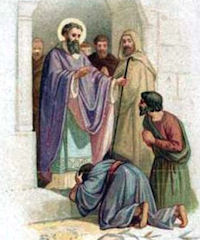 When other disciples began to arrive, Pachomius had the idea of a community of monks. He went to live at Tabennesi on the Nile in central Egypt, where he himself became the administrator, organising those who came into a community of up to forty. The regime was austere, one meal a day with an optional supper, except on Wednesdays and Fridays.
When other disciples began to arrive, Pachomius had the idea of a community of monks. He went to live at Tabennesi on the Nile in central Egypt, where he himself became the administrator, organising those who came into a community of up to forty. The regime was austere, one meal a day with an optional supper, except on Wednesdays and Fridays.Organisation
The day was organised around the liturgy, with time for manual work and devotional reading. This took the form of learning by heart extracts from the psalms and the Bible. The movement grew rapidly and Pachomius established a second monastery. Eventually there were nine monasteries for men and two for women. He appointed local superiors in charge of each of the houses. The superiors met at Easter and August to present an account of their monastery and celebrate the liturgy together.
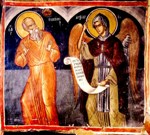
Obedience more Important than Fasting and Prayer
Pachomius considered obedience carried out with zeal more important that fasting and prayer. The monks were not ordained, nor was he himself, but a priest from outside came to celebrate the liturgy.
His Rule and Influence
Pachomius wrote a Rule, which influenced St Basil in the East and, through a Latin translation by St Jerome, St Benedict in the West. He died of a plague in 346. A.D.
____________________________
******************************
Memorable Sayings for Today
It isn't what you have, or who you are, or where you are,
or what you are doing that makes you happy or unhappy.
It is what you think about.
~ Dale Carnegie ~
******************************
Friday, Third Week of Easter
Paul is converted by the Risen Lord on the Road to Damascus.
The same Jesus is present in the Eucharist where he is our pledge of eternal communion with the Father.
FIRST READING
A reading from the Book Acts of the Apostles 9:1-20
This man is my chosen instrument to bring my name before pagans.
Saul was still breathing threats to slaughter the Lord's disciples. He had gone to the high priest and asked for letters addressed to the synagogues in Damascus, that would authorise him to arrest and take to Jerusalem any followers of the Way, men or women, that he could find.
 Suddenly, while he was travelling to Damascus and just before he reached the city, there came a light from heaven all round him. He fell to the ground, and then he heard a voice saying, ' Saul, Saul, why are you persecuting me?'
Suddenly, while he was travelling to Damascus and just before he reached the city, there came a light from heaven all round him. He fell to the ground, and then he heard a voice saying, ' Saul, Saul, why are you persecuting me?''Who are you, Lord?' he asked, and the voice answered,
'I am Jesus, and you are persecuting me.
Get up now and go into the city, and you will be told what you have to do.'
The men travelling with Saul stood there speechless, for though they heard the voice they could see no one.
Saul got up from the ground, but even with his eyes wide open he could see nothing at all, and they had to lead him into Damascus by the hand. For three days he was without his sight, and took neither food nor drink.
A disciple called Ananias who lived in Damascus had a vision in which he heard the Lord say to him, 'Ananias!' When he replied, 'Here I am, Lord', the Lord said, 'You must go to Straight Street and ask at the house of Judas for someone called Saul, who comes from Tarsus. At this moment he is praying, having had a vision of a man called Ananias coming in and laying hands on him to give him back his sight.'
When he heard that, Ananias said,
'Lord, several people have told me about this man and all the harm he has been doing to your saints in Jerusalem.
He has only come here because he holds a warrant from the chief priests to arrest everybody who invokes your name.'
The Lord replied, 'You must go all the same, because this man is my chosen instrument to bring my name
before pagans and pagan kings and before the people of Israel; I myself will show him how much he himself must suffer for my name.'
Then Ananias went. He entered the house, and at once laid his hands on Saul and said,
'Brother Saul, I have been sent by the Lord Jesus who appeared to you on your way here
so that you may recover your sight and be filled with the Holy Spirit.'
Immediately it was as though scales fell away from Saul's eyes and he could see again. So he was baptised there and then, and after taking some food he regained his strength. After he had spent only a few days with the disciples in Damascus, he began preaching in the synagogues, 'Jesus is the Son of God.'
The Word of the Lord. Thanks be to God
Responsorial Psalm Ps 116
Response Go out to the whole world; proclaim the Good News.
Or Alleluia!
1. O praise the Lord, all you nations, acclaim him all you peoples! Response
2. Strong is his love for us; he is faithful forever. Response
Gospel Acclamation Lk 24:46.26
Alleluia, Alleluia!
It was ordained that the Christ should suffer and rise from the dead, and so enter into his glory.
Alleluia!
or Jn 6: 56
Alleluia, Alleluia!
'He who eats my flesh and drinks my blood lives in me and I live in him', says the Lord.
Alleluia!
GOSPEL
The Lord be with you. And with your spirit
A reading from the holy Gospel according to John 6:52-59 Glory to you, O Lord
For my flesh is real food and my blood is real drink.
The Jews started arguing with one another:
'How can this man give us his flesh to eat?' they said.
Jesus replied:
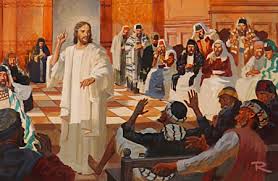 'I tell you most solemnly, if you do not eat the flesh of the Son of Man
'I tell you most solemnly, if you do not eat the flesh of the Son of Manand drink his blood, you will not have life in you.
Anyone who does eat my flesh and drink my blood has eternal life,
and I shall raise him up on the last day.
For my flesh is real food and my blood is real drink.
He who eats my flesh and drinks my blood lives in me and I live in him.
As I, who am sent by the living Father, myself draw life from the Father,
so whoever eats me will draw life from me.
He taught this doctrine at Capernaum, in the synagogue.
The Gospel of the Lord. Praise to you, Lord Jesus Christ
_________________________
Gospel Reflection Friday, Third Week of Easter John 6:52-59
The question that people ask in today’s gospel reading is a perfectly understandable one, ‘How can this man give us his flesh to eat?’ The notion of eating’s someone’s flesh is abhorrent. Yet, Jesus does not qualify what he says but, rather, he goes on to say something even more shocking. He not only calls on people to eat his flesh but to drink his blood. It is evident that Jesus is not speaking literally. His way of speaking reflects what he said at the last supper where, having taken, blessed and broken bread, he gave it to his disciples and said, ‘This is my body’. Then, having taken and blessed wine, he gave it to his disciples and said, This is my blood’.‘
Jesus identified himself, body and blood, flesh and blood, with the elements of bread and wine. He went on to instruct his disciples at the Last Supper to ‘do this in memory of me’. Ever since, the church has repeated the actions and words of Jesus at the last supper. In today’s first reading we have the dramatic story of the call of Paul. Paul will later declare in his first letter to the Corinthians, ‘The cup of blessing that we bless, is it not a communion in the blood of Christ? The bread that we break, is it not a communion in the body of Christ?’
This was the faith of the early church and of the church ever since. The Lord wishes to enter into communion with us in a very profound way at the Eucharist so that, in the words of the gospel reading, we can draw life from him. The Eucharist is a celebration of life. We are then sent out from the Eucharist to nurture and protect life in all its forms.
__________________________________
The Scripture Readings are taken from The Jerusalem Bible, published 1966 by Darton, Longman & Todd Ltd. and used with the permission of the publishers. http://dltbooks.com/
The Scripture Reflection is made available with our thanks from his book Reflections on the Weekday Readings : The Word is near to you, on your lips and in your heart by Martin Hogan and published by Messenger Publications , c/f www.messenger.ie/bookshop/
___________________________________
CÉAD LÉACHT
Sliocht as Leabhar Gníomhartha na nAspal 9:1-20
Is é sin an duine atá tofa agamsa chun m’ainm a thabhairt i láthair na bpágánach.
Ó bhí Sól ag bagairt báis ar dheisceabail an Tiarna. Chuaigh sé go dtí an t-ardsagart ag lorg litreacha uaidh le tabhairt chun na sionagóg i nDamaisc i dtreo, cibé duine dá bhfaigheadh sé ann, fear nó bean, a lean an bealach, go ndéanfadh sé iad a ghabháil agus a thabhairt ar ais go Iarúsailéim.
 Bhí sé ar an mbóthar ann agus é ag druidim le Damaisc nuair a las solas ón spéir ina thimpeall de phreib. Thit sé chun talaimh agus chuala sé an guth á rá leis:
Bhí sé ar an mbóthar ann agus é ag druidim le Damaisc nuair a las solas ón spéir ina thimpeall de phreib. Thit sé chun talaimh agus chuala sé an guth á rá leis:“A Shóil, a Shóil, cén fáth a bhfuil tú do mo ghéarleanúint?”
“Cé thú féin, a Thiarna?” d’fhiafraigh Sól.
D’fhreagair an guth:
“Is mise Íosa, an té a bhfuil tú á ghéarleanúint.
Ach éirigh i do sheasamh, gabh isteach sa chathair agus déarfar leat cad is déanta duit.”
Na fir a bhí ag taisteal leis, rinneadh staic díobh: bhí an guth le cloisteáil acu ach gan duine le feiceáil.
D’éirigh Sól den talamh, ach nuair a d’oscail sé na súile ní raibh aon léas radhairc aige.
Rug siad ar láimh air agus sheol isteach sa chathair é.
Agus bhí sé ar feadh trí lá gan radharc agus gan greim ná bolgam a bhlas.
Bhí, i nDamaisc, deisceabal darbh ainm Anainias agus labhair an Tiarna in aisling leis:
“A Anainias,” ar sé. “Teacht, a Thiarna,” d’fhreagair Anainias.
“Éirigh,” arsa an Tiarna leis, “agus gluais leat go dtí an tSráid Dhíreach mar a thugtar uirthi, agus loirg i dteach Iúdáis fear ó Tharsas arb ainm dó Sól. Tá sé ag guí ann agus chonaic sé in aisling fear darbh ainm Anainias ag teacht isteach chuige agus ag leagan a lámh air chun go mbeadh a radharc ar ais aige.”
Ach d’fhreagair Anainias:
“A Thiarna, chuala mé iomrá ar an bhfear seo óna lán daoine agus ar a bhfuil d’olc déanta aige ar an bpobal naofa in Iarúsailéim, agus anseo féin tá údarás aige ó na hardsagairt gach duine dá nglaonn ar d’ainmse a ghabháil.”
“Gluais leat,” arsa an Tiarna leis, “mar is é sin an duine atá tofa agamsa chun m’ainm a thabhairt i láthair na bpágánach agus na ríthe agus i láthair chlann Iosrael. Taispeánfaidh mise dó a bhfuil le fulaingt aige ar son m’ainmse.”
D’imigh Anainias leis, agus ar dhul isteach sa teach dó leag sé a lámha air, á rá:
“A Shóil, a bhráthair, is é an Tiarna a sheol chugat mé – an Íosa a thaispeáin é féin duit ar do bhealach anseo – chun go mbeadh do radharc arís agat agus go líonfaí den Spiorad Naomh thú.” Agus de phreib thit mar a bheadh screamh dá shúile agus tháinig a radharc arís dó; agus ar éirí dó ina sheasamh, baisteadh é. Agus tar éis dó rud a ithe tháinig a neart arís ann. D’fhan Sól ar feadh tamaill leis na deisceabail i nDamaisc. Thosaigh sé láithreach ag fógairt sna sionagóga gurb é Íosa mac Dé.
Briathar an Tiarna Buíochas le Dia
Salm le Freagra Sm 116
Freagra Imígí faoin domhan uile agus fógraígí an soiscéal don chruthaíocht uile.
Malairt freagra Alleluia!
1. Molaigí an Tiarna, a chiníocha uile; moladh na náisiúin go léir é. Freagra
2. Óir is daingean é go deimhin, a bhuanghrá dúinn; maireann a dhílseacht go brách. Freagra
SOISCÉAL
Go raibh an Tiarna libh. Agus le do spiorad féin
Sliocht as an Soiscéal naofa de réir Naomh Eoin 6:52-59 Glóir duit, a Thiarna
Is bia go fíor mo chuid feola agus is deoch go fíor mo chuid fola.
San am sin bhí na Giúdaigh ansin ag aighneas le chéile á rá:
“Conas is féidir leis an duine seo a fheoil a thabhairt dúinn le hithe?”
Dúirt Íosa leo:
Amen, Amen, a deirim libh, mura n-íosfaidh sibh feoil Mhac an Duine, agus a chuid fola a ól, ní bheidh beatha agaibh ionaibh.

An té a itheann m’fheoil agus a olann m’fhuil,
tá an bheatha shíoraí aige, agus tógfaidh mé suas é an lá deireanach.
Is bia go fíor mo chuid feola agus is deoch go fíor mo chuid fola.
An té a itheann m’fheoil agus a ólann m’fhuil cónaíonn sé ionamsa agus cónaímse ann. Amhail mar a chuir an tAthair beo mise uaidh,agus mar is beo mise tríd an Athair,
mar an gcéanna, an té a itheann mise, mairfidh sé tríom.
Is é seo an t-arán a tháinig anuas ó neamh.
Ní ionann is an manna ar ith bhur n-aithreacha é agus go bhfuil siad marbh;
an té a itheann an t-arán seo, mairfidh sé go deo.”
Dúirt sé na nithe seo i gCafarnáum agus é ag teagasc sa tsionagóg.
Soiscéal an Tiarna. Moladh duit, a Chriost
AN BÍOBLA NAOFA
© An Sagart
The Fourth Sunday of Easter, Year C
Good Shepherd Sunday
Day of Prayer for Vocations
For people of faith to respond to the Lord and dedicate their lives to his Gospel work.
FIRST READING
A reading from the Acts of the Apostles 13:14. 43-52
We must turn to the pagans.
Paul and Barnabas carried on from Perga till they reached Antioch in Pisidia. Here they went to synagogue on the sabbath and took their seats. When the meeting broke up many Jews and devout converts joined Paul and Barnabas and in their talks with them Paul and Barnabas urged them to remain faithful to the grace God had given them.

The next sabbath almost the whole town assembled to hear the word of God. When they saw the crowds, the Jews, prompted by jealousy, used blasphemies and contradicted everything Paul said. Then Paul and Barnabas spoke out boldly.
'We had to proclaim the word of God to you first, but since you have rejected it,
since you do not think yourselves worthy of eternal life, we must turn to the pagans.
For this is what the Lord commanded us to do when he said:
"I have made you a light for the nations, so that my salvation may reach the ends of the earth."
It made the pagans very happy to hear this and they thanked the Lord for his message; all who were destined for eternal life became believers. Thus the word of the Lord spread through the whole countryside.
But the Jews worked upon some of the devout women of the upper classes and the leading men of the city and persuaded them to turn against Paul and Barnabas and expel them from their territory. So they shook the dust from their feet in defiance and went off to Iconium; but the disciples were filled with joy and the Holy Spirit.
The Word of the Lord Thanks be to God.
Responsorial Psalm Ps 99
Response We are his people, the sheep of his flock.
or Alleluia, alleluia, alleluia!
1. Cry out with joy to the Lord, all the earth. Serve the Lord with gladness.
Come before him, singing for joy. Response
2. Know that he, the Lord, is God. He made us, we belong to him,
we are his people, the sheep of his flock. Response
3. Indeed, how good is the Lord, eternal his merciful love.
He is faithful from age to age. Response
SECOND READING Apocalypse 7:9.14-17
The Lamb will be their shepherd and will lead them to springs of living water.
I, John saw a huge number, impossible to count, of people from every nation, race, tribe and language; they were standing in front of the throne and in front of the Lamb, dressed in white robes and holding palms in their hands.

One of the elders said to me,
'These are the people who have been through the great persecution, and because they have washed their robes white again in the blood of the Lamb, they now stand in front of God's throne and serve him day and night in his sanctuary; and the One who sits on the throne will spread his tent over them.
They will never hunger or thirst again; neither the sun nor scorching wind will ever plague them, because the Lamb who is at the throne will be their shepherd and will lead them to
springs of living water; and God will wipe away all tears from their eyes.'
The Word of the Lord Thanks be to God.
Gospel Acclamation Jn 10: 14
Alleluia, alleluia!
I am the good shepherd; I know my own and my own know me.
Alleluia!
THE GOSPEL John 10:27-30
I give eternal life to the sheep that belong to me.
Jesus said:

'The sheep that belong to me listen to my voice;
I know them and they follow me.
I give them eternal life;
they will never be lost and no one will ever steal them from me.
The Father who gave them to me is greater than anyone,
and no one can steal from the Father.
The Father and I are one.'
The Gospel of the Lord Praise to you, Lord Jesus Christ.
*****************************
For homily resources for this Sunday's Gospel click here: https://www.catholicireland.net/sunday-homily/
Taken from THE JERUSALEM BIBLE, published and copyright 1966, by Darton, Longman and Todd Ltd and Doubleday, a division of Random House Inc, and used by permission of the publishers.
Sliocht as Gníomhartha na nAspal 13:14. 43-52
Táimidne ag iompú chun na bpágánach.
Ar dhul trí Peirge do Phól agus Barnabas tháinig siad go dtí Aintíoch na Pisíde. Chuaigh siad isteach sa tsionagóg lá na sabóide agus shuigh siad fúthu. Agus nuair a scoir an comhthionól, bhí cuid mhaith de na Giúdaigh agus de na hiompaithigh dhiaganta a lean Pól agus Barnabas. Ina gcomhrá leo mhol Pól agus Barnabas dóibh bheith buanseasmhach i ngrásta Dé.

An tsabóid dár gcionn tháinig an chathair ar fad beagnach le chéile ag éisteacht le briathar Dé. Nuair a chonaic na Giúdaigh na sluaite daoine, bhí siad lán d’fhormad agus bhréagnaigh siad go tarcaisniúil gach a raibh á rá ag Pól.
Ach dúirt Pól agus Barnabas leo go neamhbhalbh:
“Is daoibhse ab éigean briathar Dé a labhairt ar dtús; ach ós rud é go bhfuil sibh ag cur suas de agus gur dóigh libh féin nach fiú sibh an bheatha shíoraí a bheith agaibh, táimidne ag iompú chun na bpágánach.
Mar sin é an t-ordú atá faighte ón Tiarna againn:
‘ Tá tú ceaptha agam le bheith i do sholas do na náisiúin,
ionas go mbeidh tú i d’ábhar slánaithe go himeall an domhain.’”
Bhí áthas ar na págánaigh an méid sin a chloisteáil agus bhí ardmholadh acu ar bhriathar an Tiarna; agus an méid acu a bhí réamhcheaptha don bheatha shíoraí, ghlac siad an creideamh, agus bhí briathar Dé á fhógairt go forleathan ar fud na tíre go léir.
Ach rinne na Giúdaigh séideadh faoi mhná uaisle diaganta na cathrach agus faoi na cinn urra, thosaigh siad ar ghéarleanúint a dhéanamh ar Phól agus ar Bharnabas agus thiomáin amach as an dúiche iad. Chroith siadsan an deannach dá gcosa orthu agus as go brách leo go hIocoiniam. Agus bhí na deisceabail lán d’áthas agus den Spiorad Naomh.
Briathar an Tiarna Buíochas le Dia
Salm le Freagra Sm 99
Freagra Sinne a phobal agus caoirigh a pháirce.
Malairt Freagra Alleluia!
1. Gairdígí don Tiarna, a thíortha uile. Fónaigí don Tiarna go lúcháireach.
Tagaigí ina láthair le hamhráin áthais. Freagra
2. Bíodh a fhios agaibh gurb é an Tiarna is Dia ann. Eisean a rinne sinn; is leis féin sinn;
sinne a phobal agus caoirigh a pháirce. Freagra
3. Á, nach maith é go deimhin an Tiarna, nach marthanach a thrócaire ghrámhar!
Is dílis é ó ghlúin go chéile Freagra
DARA LÉACHT Apacailipsis 7:9. 14-17
Beidh an tUan mar aoire acu, agus treoróidh sé iad go toibreacha na beatha.
 Chonaic mise. Eoin, mathshlua mór nárbh fhéidir d’aon duine a chomhaireamh as gach cine agus treibh agus pobal agus teanga; bhí siad ina seasamh os comhair na ríchathaoireach agus os comhair an Uain, iad gléasta in éidí geala agus craobhacha pailme acu ina lámha.
Chonaic mise. Eoin, mathshlua mór nárbh fhéidir d’aon duine a chomhaireamh as gach cine agus treibh agus pobal agus teanga; bhí siad ina seasamh os comhair na ríchathaoireach agus os comhair an Uain, iad gléasta in éidí geala agus craobhacha pailme acu ina lámha.Dúirt duine liom:
“Is iadsan an dream atá gafa tríd an duainéis mhór; nigh siad agus gheal siad a n-éidí i bhfuil an Uain. Uime sin tá siad os comhair ríchathaoir Dé, agus déanann siad seirbhís dó de lá agus d’oíche ina theampall; agus, an té atá ina shuí sa ríchathaoir, beidh sé ina measc á gcosaint; ní bheidh tart orthu feasta, ná ocras, ná ní chiapfaidh an ghrian iad ná an brothall dearg. Óir, an tUan atá i lár baill ag an ríchathaoir, is é a bheidh mar aoire acu, agus treoróidh sé iad go toibreacha na beatha; agus glanfaidh Dia an uile dheoir dá súile.’
Briathar an Tiarna Buíochas le Dia
Alleluia Véarsa Eo 10: 14
Alleluia, Alleluia!
Is mise an t-aoire maith,' a deir an Tiarna.
Aithním mo chaoirigh féin, agus aithníonn mo chaoirigh féin mé'
Alleluia!
SOISCÉAL
Go raibh an Tiarna libh. Agus le do spiorad féin
Sliocht as Soiscéal naofa de réir Naomh Eoin 10:27-30 Glóir duit, a Thiarna.
An bheatha shíoraí agam á tabhairt do mo chaoirigh.

San am sin dúirt Íosa:
Éisteann mo chaoirigh le mo ghlór, agus aithním iad, agus leanann siad mé.
Tá an bheatha shíoraí agam á tabhairt dóibh,
agus ní chaillfear go deo iad, ná ní fhuadóidh aon duine as mo láimh iad.
M’Athair a thug dom iad, is mó é ná cách, agus ní féidir d’aon duine fuadach ó láimh m’Athar.
Is aon mise agus an tAthair.”
Soiscéal an Tiarna. Moladh duit, a Chriost
AN BÍOBLA NAOFA
© An Sagart

